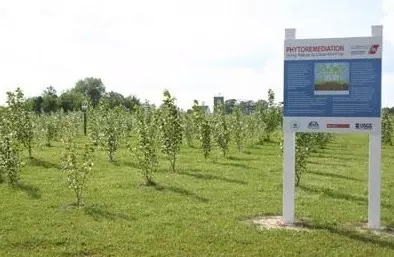Phytoremediation
Phytoremediation aims to reclaim contaminated sites through the exploitation of plant-driven processes, for instance reclaiming industrial areas, mines, landfills, etc.
In collaboration with among the most relevant Italian research institutes in the field (CNR-IBAF, Department of Molecular Sciences and Nanosystems of Cà Foscari university of Venice), IRIDRA can assist its client in the reclaim of contaminated sites with phytoremediation techniques.

Advantages
- low investment and O&M costs
- potential reuse of biomass for energy production
- reduction of groundwater contamination
- erosion reduction
Phytoremediation is a technique used for the remediation of contaminated sites, in which the plants are used to extract substances from contaminated soil and sediments and accumulate them in their tissues. Up to 450 plant species were identified as potential metal accumulators in 2010.
The processes used by the phytoremediation are the following.
| | | |
Contaminant removal processes | Removal process | Target contaminants |
Phytoextraction | Accumulation in the vegetative tissue, removal by harvesting | Mostly inorganics |
Phytodegradation | Degradation within the vegetative tissue, removal by enzymatic plant uptake | Oxidative and nitro-reducer contaminants |
Phytostimulation | Degradation by the microorganisms present in the root rhizosphere | PCBs, PAHs |
Phytostabilization | Contaminant entrapped in the rhizosphere | Metals and organic contaminants |
Phytovolatilization | Volatile contaminants released into the atmosphere | Se, As, Hg, Trichlorethylene, Methyl tert-butyl ether |
Applications
The interest into the phytoremediation is growth in the last years, leading to highlight a number of potential applications for the remediation of, for instance, dismissed industrial areas, rehabilitation of dismissed industrial areas, querries, landfills, as well as remediation of area interested by episodic contamination, channel sediments or contaminated harbours. Another interesting application is the remediation of "light" polluted peri-urban areas, in order to implement new crops.
Advantages
The phytoremediation provides several advantages in terms of low costs, use of nature-based solutions, potential reuse of biomass for energy production, reduction of groundwater contamination, erosion control. The phytoremediation is also characterized by a low environmental impact, which can be used in combination with conventional remediation solutions.

An example of phytoremediation (source CNR-IBAF)

